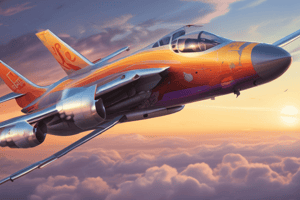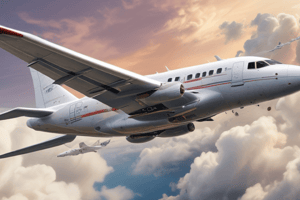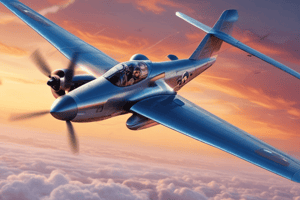Podcast
Questions and Answers
What is the primary benefit of optimizing airfoil design for maximum lift with minimal drag?
What is the primary benefit of optimizing airfoil design for maximum lift with minimal drag?
- Increased maneuverability
- Enhanced controllability
- Reduced maintenance costs
- Improved fuel efficiency (correct)
What is the significance of the center of pressure in airfoil design?
What is the significance of the center of pressure in airfoil design?
- It influences the airfoil's drag coefficient
- It affects the aerodynamic balance and stability of the aircraft (correct)
- It determines the airfoil's maximum lift capacity
- It represents the point where the airfoil's weight is concentrated
What is the primary advantage of simulation tools in airfoil design?
What is the primary advantage of simulation tools in airfoil design?
- They facilitate the calculation of aerodynamic forces and moments
- They allow for the observation of wind tunnel tests
- They enable the creation of physical prototypes
- They provide a platform to test and improve airfoil designs (correct)
What happens when the center of pressure moves significantly with changes in angle of attack?
What happens when the center of pressure moves significantly with changes in angle of attack?
What is the primary goal of airfoil design optimization?
What is the primary goal of airfoil design optimization?
What is the relationship between the center of pressure and the airfoil's aerodynamic forces and moments?
What is the relationship between the center of pressure and the airfoil's aerodynamic forces and moments?
What is the primary advantage of using simulation tools to analyze airfoil performance?
What is the primary advantage of using simulation tools to analyze airfoil performance?
What is the significance of the airfoil's angle of attack in aerodynamic design?
What is the significance of the airfoil's angle of attack in aerodynamic design?
What is the primary benefit of achieving a stable airfoil design?
What is the primary benefit of achieving a stable airfoil design?
What is the primary role of simulation in airfoil design?
What is the primary role of simulation in airfoil design?
Aerodynamic efficiency is solely dependent on the lift forces of the airfoil.
Aerodynamic efficiency is solely dependent on the lift forces of the airfoil.
The center of pressure is a fixed point along the chord line of an airfoil.
The center of pressure is a fixed point along the chord line of an airfoil.
Simulation tools can only analyze the lift forces of an airfoil.
Simulation tools can only analyze the lift forces of an airfoil.
Aerodynamic balance and stability are not affected by the position of the center of pressure.
Aerodynamic balance and stability are not affected by the position of the center of pressure.
Airfoil designs with minimal center of pressure movement are more maneuverable.
Airfoil designs with minimal center of pressure movement are more maneuverable.
Simulation is only used to test and improve airfoil designs, but not to optimize performance.
Simulation is only used to test and improve airfoil designs, but not to optimize performance.
The primary goal of airfoil design is to achieve maximum lift with minimal drag, regardless of speed and overall performance.
The primary goal of airfoil design is to achieve maximum lift with minimal drag, regardless of speed and overall performance.
The position of the center of pressure does not affect the controllability of the aircraft.
The position of the center of pressure does not affect the controllability of the aircraft.
Simulation tools can only analyze the performance of airfoils at a single airspeed.
Simulation tools can only analyze the performance of airfoils at a single airspeed.
Theoretical design is sufficient to optimize airfoil performance, without the need for simulation or practical application.
Theoretical design is sufficient to optimize airfoil performance, without the need for simulation or practical application.
How does a well-designed airfoil impact the speed and overall performance of an aircraft, and what metrics do simulation tools enable analysis of?
How does a well-designed airfoil impact the speed and overall performance of an aircraft, and what metrics do simulation tools enable analysis of?
What is the relationship between the center of pressure and aerodynamic balance and stability, and why is its position crucial?
What is the relationship between the center of pressure and aerodynamic balance and stability, and why is its position crucial?
How do simulation tools facilitate the refinement of airfoil shapes to optimize performance, and what are the resulting benefits?
How do simulation tools facilitate the refinement of airfoil shapes to optimize performance, and what are the resulting benefits?
What is the trade-off between center of pressure movement and controllability, and how does simulation help in striking a balance?
What is the trade-off between center of pressure movement and controllability, and how does simulation help in striking a balance?
How do airfoil designs optimized for maximum lift with minimal drag impact the overall efficiency of an aircraft, and what other factors must be considered?
How do airfoil designs optimized for maximum lift with minimal drag impact the overall efficiency of an aircraft, and what other factors must be considered?
What is the significance of observing lift forces in a simulated environment, and how does this impact airfoil design optimization?
What is the significance of observing lift forces in a simulated environment, and how does this impact airfoil design optimization?
How do changes in angle of attack affect the center of pressure, and what are the implications for airfoil design?
How do changes in angle of attack affect the center of pressure, and what are the implications for airfoil design?
What is the primary advantage of using simulation tools in airfoil design, and how does this approach differ from theoretical design?
What is the primary advantage of using simulation tools in airfoil design, and how does this approach differ from theoretical design?
How does the position of the center of pressure affect the aerodynamic forces and moments on an airfoil, and what are the implications for airfoil design?
How does the position of the center of pressure affect the aerodynamic forces and moments on an airfoil, and what are the implications for airfoil design?
What is the ultimate goal of airfoil design optimization, and how do simulation tools contribute to achieving this goal?
What is the ultimate goal of airfoil design optimization, and how do simulation tools contribute to achieving this goal?
Flashcards
Airfoil
Airfoil
The shape of an aircraft's wing, designed to optimize performance by creating a pressure differential that generates lift.
Bernoulli's Principle
Bernoulli's Principle
Principle stating that faster-moving air exerts less pressure than slower-moving air, crucial for understanding lift generation in airfoils.
Center of Pressure
Center of Pressure
The point on an aircraft's wing where the total lift force is considered to act; its position affects aircraft stability.
Airfoil Design Simulation
Airfoil Design Simulation
Signup and view all the flashcards
Aerodynamic Efficiency
Aerodynamic Efficiency
Signup and view all the flashcards
Creating Lift
Creating Lift
Signup and view all the flashcards
Airfoil Key Elements
Airfoil Key Elements
Signup and view all the flashcards
Aerodynamic Efficiency Optimization
Aerodynamic Efficiency Optimization
Signup and view all the flashcards
Computational Fluid Dynamics (CFD)
Computational Fluid Dynamics (CFD)
Signup and view all the flashcards
Simulation
Simulation
Signup and view all the flashcards
Center of Pressure Definition
Center of Pressure Definition
Signup and view all the flashcards
Importance of Shift Observation
Importance of Shift Observation
Signup and view all the flashcards
Study Notes
Fundamentals of Flight: Synthesis and Application
- The airfoil is the heart of an aircraft's wing, and its shape is crucial for achieving optimal performance.
- Each curve and angle of an airfoil is deliberate, with specific characteristics that influence how an aircraft interacts with the air.
- The shape of an airfoil creates a pressure differential, which generates lift, the force that keeps planes aloft.
Lift and Airfoil Design
- Bernoulli's principle explains how air moving over the top of the wing accelerates, leading to lower pressure compared to the slower-moving air underneath.
- A thick, cambered airfoil offers more lift at lower speeds, ideal for small personal aircraft.
- A sleek, thin airfoil favors the high-speed realm of jet fighters.
Center of Pressure
- The center of pressure is the point on the aircraft's wing where lift forces are said to act.
- As the angle of attack shifts, the center of pressure moves along the wing, affecting the equilibrium of the aircraft.
- The center of pressure must be maintained to ensure stability and control.
Airfoil Design Simulation
- Simulation is a crucial tool in aerodynamics, allowing designers to model complex scenarios, predict performance, and make adjustments before manufacturing.
- Simulation enables the analysis of airfoil designs, including lift coefficient, drag coefficient, and critical angle of attack.
- Through simulation, designers can identify design characteristics and make predictions about how they will perform in real-world scenarios.
Simulation in Aerodynamics
- Simulation allows engineers to explore the intricate behaviors of airfoils under various conditions without the need for expensive and time-consuming physical prototypes.
- Simulation assesses how modifications to an airfoil's design alter the pressure distribution across its surface, affecting lift generation.
- Simulation tools enable the analysis of performance metrics, giving insights into how the airfoil will behave at different airspeeds and flight regimes.
Aerodynamic Efficiency
- Aerodynamic efficiency is not just about lift; it's also about how the airfoil design impacts the speed and overall performance of the aircraft.
- A well-designed airfoil will reduce drag, allowing for higher speeds and better fuel efficiency.
Stability and Control
- The center of pressure must be maintained to ensure stability and control.
- When the center of pressure moves significantly with changes in angle of attack, it can impact the controllability of the aircraft.
- Simulation makes it possible to quantify these effects and to strike a balance that meets the desired flight characteristics.
Fundamentals of Flight
- Aircraft design is crucial for aerodynamic efficiency and performance.
- The shape of an airfoil is not just aesthetically pleasing, but is deliberately designed for optimal performance.
Airfoil Design
- The airfoil shape is the building block of lift, which is the force that keeps planes aloft.
- A well-designed airfoil manipulates airflow to create a pressure differential, resulting in lift.
- Air moving over the top of the wing accelerates, leading to lower pressure compared to the slower-moving air underneath.
Aerodynamic Efficiency
- Speed and performance are closely related in aerodynamics, and the shape of the airfoil is the key factor.
- A thick, cambered airfoil offers more lift at lower speeds, ideal for small personal aircraft.
Airfoil Design Simulation
- Simulation is a crucial tool in aerodynamics, allowing engineers to model complex scenarios, predict airfoil design performance, and make adjustments without physical testing.
- Key elements of an efficient airfoil design include camber, thickness, and chord length, which directly affect air flow and lift production.
Aerodynamic Efficiency Optimization
- Optimizing airfoil design for aerodynamic efficiency involves maximizing lift while minimizing drag, improving aircraft performance in terms of speed and fuel consumption.
- Computational fluid dynamics (CFD) analysis allows for detailed insights into air flow patterns, pressure distribution, and aerodynamic forces.
Real-World Applications
- Aircraft designers rely on simulation data to predict the behavior of new wing designs under various conditions, driving advancements in speed, efficiency, and safety in aviation.
- Simulation plays a pivotal role in airfoil design and analysis, allowing engineers to explore intricate behaviors of airfoils under various conditions without physical prototypes.
Simulation in Aerodynamics
- Simulation enables designers to identify design characteristics, predict performance, and optimize airfoil design for maximum lift with minimal drag.
- Simulation tools enable analysis of performance metrics, providing insights into how airfoil design affects speed and overall aircraft performance.
Center of Pressure
- The center of pressure is a vital concept in airfoil design, representing the point along the chord line where total pressure forces act.
- The center of pressure shift with changes in angle of attack, affecting aerodynamic forces and moments on the airfoil.
- Simulation allows for observation of these shifts, essential for predicting and ensuring stable flight characteristics.
Fundamentals of Flight
- Aircraft design is crucial for aerodynamic efficiency and performance.
- The shape of an airfoil is not just aesthetically pleasing, but is deliberately designed for optimal performance.
Airfoil Design
- The airfoil shape is the building block of lift, which is the force that keeps planes aloft.
- A well-designed airfoil manipulates airflow to create a pressure differential, resulting in lift.
- Air moving over the top of the wing accelerates, leading to lower pressure compared to the slower-moving air underneath.
Aerodynamic Efficiency
- Speed and performance are closely related in aerodynamics, and the shape of the airfoil is the key factor.
- A thick, cambered airfoil offers more lift at lower speeds, ideal for small personal aircraft.
Airfoil Design Simulation
- Simulation is a crucial tool in aerodynamics, allowing engineers to model complex scenarios, predict airfoil design performance, and make adjustments without physical testing.
- Key elements of an efficient airfoil design include camber, thickness, and chord length, which directly affect air flow and lift production.
Aerodynamic Efficiency Optimization
- Optimizing airfoil design for aerodynamic efficiency involves maximizing lift while minimizing drag, improving aircraft performance in terms of speed and fuel consumption.
- Computational fluid dynamics (CFD) analysis allows for detailed insights into air flow patterns, pressure distribution, and aerodynamic forces.
Real-World Applications
- Aircraft designers rely on simulation data to predict the behavior of new wing designs under various conditions, driving advancements in speed, efficiency, and safety in aviation.
- Simulation plays a pivotal role in airfoil design and analysis, allowing engineers to explore intricate behaviors of airfoils under various conditions without physical prototypes.
Simulation in Aerodynamics
- Simulation enables designers to identify design characteristics, predict performance, and optimize airfoil design for maximum lift with minimal drag.
- Simulation tools enable analysis of performance metrics, providing insights into how airfoil design affects speed and overall aircraft performance.
Center of Pressure
- The center of pressure is a vital concept in airfoil design, representing the point along the chord line where total pressure forces act.
- The center of pressure shift with changes in angle of attack, affecting aerodynamic forces and moments on the airfoil.
- Simulation allows for observation of these shifts, essential for predicting and ensuring stable flight characteristics.
Studying That Suits You
Use AI to generate personalized quizzes and flashcards to suit your learning preferences.




